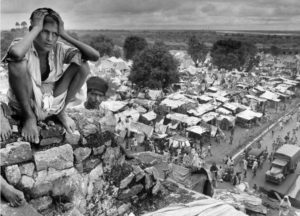India’s ‘great divide’ mirrored by modern exodus
The largest single movement of people in human history occurred in 1947 when India and Pakistan were partitioned in what were literally the last days of the British Raj.
When the new Islamic country of Pakistan split from India it was thought there might be instances of people moving across the new borders but that India’s ethnic and religious communities were so intermingled that mass movements would not happen.
What did happen was a bloody and massive upheaval with around 16 million Hindus, Sikhs and Muslims driven out of their communities by an explosion of pent up suspicion and rivalry.
Across India, communities that had coexisted peacefully for almost a thousand years attacked each other in a terrifying outbreak of sectarian violence, with Hindus and Sikhs on one side and Muslims on the other.
The partition of the old Indian empire evolved into a mutual genocide as unexpected as it was unprecedented.
In Punjab and Bengal—provinces on India’s borders with West and East Pakistan, respectively—the carnage was particularly horrific.
Massacres, arson, forced conversions, mass abductions, and savage sexual violence characterised some of the violence.
By 1948 as the great migration ended between one and two million were left dead.
Perhaps surprisingly few photographs exist that captured the epoch marking exodus.
 But LIFE Magazine photographer Margaret Bourke-White captured a series of remarkable images that help to tell the story of human misery on a mass scale.
But LIFE Magazine photographer Margaret Bourke-White captured a series of remarkable images that help to tell the story of human misery on a mass scale.
Now, Time-Life have put the images in a new web-based gallery and with the recovery of notes written by reporter Lee Etingon from the LIFE archives, nearly 70 years later, we can see some of the small details that return some humanity to the nameless suffering figures in the images.
Bourke-White and Etingon obtained a Jeep and an escort of a few soldiers from the military authorities for trip into the Punjab.
“We were dressed in khaki shirts and slacks and we carried bedrolls, a four-gallon thermos of purified water, camera equipment and typewriter,” Etingon wrote.
The two women were constantly close to danger. Driving towards Lahore, they encountered a stalled truck packed with refugees, which was in the process of being surrounded “by about 30 men with ten-foot-long spears.”
The soldiers in their escort intervened. “The captain shot one attacker, then leaped into the Jeep. A stray shot followed us as we drove off,” wrote Eitingon.
The British, nearly bankrupt and exhausted from World War II, considered the proposal of partition by the Viceroy of India, Lord Mountbatten, and endorsed by nationalist Indian and proto-Pakistani statesmen, provided a dignified means of retreating from the Indian empire.
What they had not bargained for was that terrified populations, spurred by a new kind of demagogic politics, would flee or be driven from the lands which they had occupied for centuries.
The events chronicled in LIFE in 1947 are chillingly familiar. We are seeing similar images in many parts of the world today.
See Bourke-White’s photographs at: http://time.com/4421746/margaret-bourke-white-great-migration/
Laurie Nowell
AMES Australia Senior Journalist












